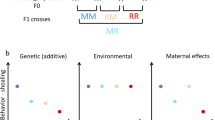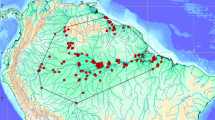Abstract
Species-specific elements of the paradise fish's ethogram were recorded in one familiar and three different unfamiliar environments, which were designed to model certain features of this species' natural habitat: (1) a densely vegetated home range, (2) a novel open field, (3) a small novel place, and (4) a small novel place with a predator. The inheritance of the behavioral elements was investigated employing a five-times-replicated diallel cross among three inbred strains. A detailed Hayman analysis of variance and a variance-covariance analysis were performed to uncover the genetic architectures of these phenotypes. Additive genetic effects and/or ambidirectional dominance was found to be characteristic of most species-specific behavioral elements studied, suggesting an evolutionary history of stabilizing selection.
Similar content being viewed by others
References
Altbäcker, V., and Csányi, V. (1990). Predator in the shuttle-box: An ethological analysis of passive avoidance conditioning.Behaviour (in press).
BMDP (1981).Statistical Software. User's Digest, Department of Biomathematics, University of California, Los Angeles.
Broadhurst, P. L., and Jinks, J. L. (1974). What genetical architecture can tell us about the natural selection of behavioural traits. In van Abeelen, J. H. F. (ed.),The Genetics of Behaviour, North-Holland, Amsterdam and American Elsevier, New York.
Crusio, W. E. (1990). Quantitative genetics. In Goldowitz, D., Wahlsten, D., and Wimer, R. (eds.),Techniques for the Genetic Analysis of Brain and Behavior: Focus on the Mouse, Elsevier, Amsterdam (in press).
Crusio, W. E., and van Abeelen, J. H. F. (1986). The genetic architecture of behavioural responses to novelty in mice.Heredity 56:55–63.
Crusio, W. E., Kerbusch, J. M. L. and van Abeelen, J. H. F. (1984). The replicated diallel cross: A generalized method of analysis.Behav. Genet 14:81–104.
Crusio, W. E., Schwegler, H., and van Abeelen, J. H. F. (1989). Behavioral responses to novelty and structural variation of the hippocampus in mice. I. Quantitative-genetic analysis of behavior in the open-field.Behav. Brain Res. 32:75–80.
Csányi, V., and Gerlai, R. (1988). Open-field behavior and the behavior-genetic analysis of the paradise fish (Macropodus opercularis).J. Comp. Psychol. 102:326–336.
Csányi, V., Tóth, P., Altbäcker, V., Dóka, A., and Judit, Gervai (1985a). Behavioural elements of the paradise fish (Macropodus opercularis). I. Regularities of defensive behaviour.Acta Biol. Hung. 36:93–114.
Csányi, V., Tóth, P., Altbäcker, V., Dóka, A., and Judit, Gervai (1985b). Behavioral elements of the paradise fish (Macropodus opercularis). II. A functional analysis.Acta Biol. Hung. 36:115–130.
Falconer, D. S. (1960).Introduction to Quantitative Genetics, Ronald Press, New York.
Forselius, S. (1957). Studies of anabantoid fishes. I. A quantitative description of the reproductive behaviour.Zool. Bidr. 32:93–302.
Francis, R. C. (1984). The effects of bidirectional selection for social dominance on agonistic behavior and sex ratios in the paradise fish (Macropodus opercularis).Behaviour 90:25–45.
Gerlai, R., and Csányi, V. (1987). The behaviour of the paradise fish (Macropodus opercularis) in two different open-fields. A correlation study.Acta Biol. Hung. 38:225–234.
Gervai, J., and Csányi, V. (1984). Artificial gynogenesis and mapping of gene-centromere distances in the paradise fish (Macropodus opercularis).Theor. Appl. Genet. 68:481–485.
Gervai, J., and Csányi, V. (1985). Behavior-genetic analysis of the paradise fish (Macropodus opercularis). I. Characterization of the behavioral responses of inbred strains in novel environments: A factor analysis.Behav. Genet. 15:503–519.
Hayman, B. I. (1954a). The analysis of variance of diallel tables.Biometrics 10:235–244.
Hayman, B. I. (1954b). The theory and analysis of diallel crosses.Genetics 39:789–809.
Mather, K., and Jinks, J. L. (1982).Biometrical Genetics: The Study of Continuous Variation, 3rd ed., Chapman and Hall, London.
Monostory, Zs., Nagy, A., Gervai, J., and Csányi, V. (1984). Polymorphism in the inheritance of serum esterases and globulins in the paradise fish.Anim. Blood Groups Biochem. Genet. 15:1–11.
Author information
Authors and Affiliations
Rights and permissions
About this article
Cite this article
Gerlai, R., Crusio, W.E. & Csányi, V. Inheritance of species-specific behaviors in the paradise fish (Macropodus opercularis): A diallel study. Behav Genet 20, 487–498 (1990). https://doi.org/10.1007/BF01067715
Received:
Accepted:
Issue Date:
DOI: https://doi.org/10.1007/BF01067715




